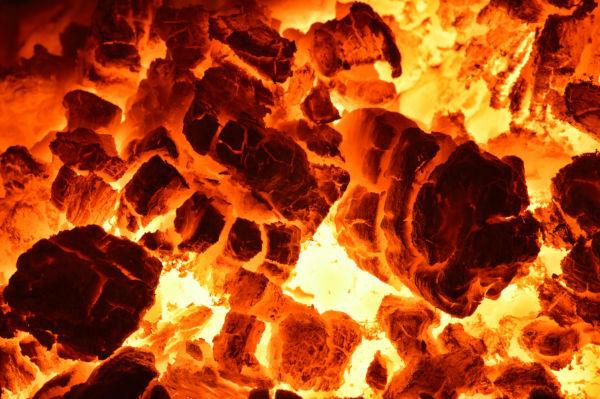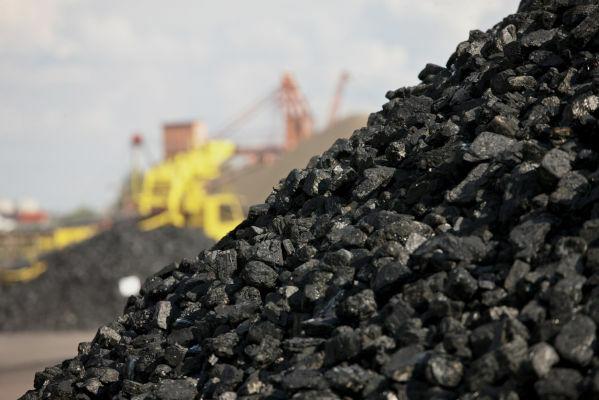O mineral coal it's a mineral non-renewable, more specifically a sedimentary rock originated thousands of years ago and found underground in deposits of organic origin. It is, according to the National Electric Energy Agency (Aneel), the fossil fuel with greater availability in the world and one of the first sources of energy used by man. It began to be used on a large scale during the period of Industrial Revolution.
Lookalso:What are renewable energy sources?
Origin
Coal has existed for thousands of years in deposits of plant origin, formed through the decomposition of organic matter without the presence of oxygen. The material originating from the plant remains is buried and compacted, suffering the action of bacteria, as well as of the pressure and heat conditions in the environment of the deposit, thus forming, over time, the coal mineral. Its formation corresponds to the Carboniferous Period, during the Paleozoic Era.
Coal can be found, according to the National Department of Mineral Production (DPMN), in regions of low temperatures or temperate climate, being located on all continents. In these places, vegetables are charred before they rot.
Composition
Carbon is the main compound of coal, presenting, according to the Company of Research and Mineral Resources, the content of approximately 55% to 95% of the element, making there are types of coal more or less rich in carbon. The carbon content is what defines the geological maturity of the mineral, known as rank. Also found in this fossil fuel, according to the DNPM, are sulfur, nitrogen, oxygen and hydrogen.
Types of coal
The formation of coal corresponds to stages production, specifically specified by the presence of carbon. From the lowest to the highest concentration of the substance, we have the four main types of mineral coal:
Peat: plant material that has a carbon content between 55% and 60% and allows the identification of plant remains. Its calorific value is less than 4,000 kcal.
lignite: sedimentary rock formed from the compression of peat. It has a carbon content between 67% and 78%. Its calorific value is less than 4,000 kcal.
Bituminous coal or hard coal: sedimentary rock composed of bitumen (liquid mixture of dark color and high viscosity). It has a carbon content between 80% to 90%. Its calorific value is between 7,000 to 8,650 kcal.
anthracite: compact and solid carbon type. It has a carbon content of 96% and corresponds to the purest form of mineral coal. Contains little or no bitumen.
knowmore:Difference between coal and coking coal
Use of coal

Through combustion, coal can generate several by-products, as well as generate energy.
The use of coal became more intense in the mid-18th century, a period corresponding to the Industrial Revolution. Coal was used to enable the operation of steam engines. Currently, the use of the mineral has decreased, as other energy sources have been more explored, such as oil and natural gas. There is also a global trend that aims to replace the use of non-renewable sources, such as coal and oil, with alternative energy sources, such as solar energy and the wind energy.
According to the International Energy Agency, coal accounts for 41% of total electricity production, being, therefore, the most used font in the world for this purpose. However, the production of coal is not proportional to its availability, with the industry of Petroleum ahead of the production system.
O use of coal is related to its properties, such as the powercalorific that enables the generation of energy through burning. According to the National Department of Mineral Production (DNPM), coals that have a lower calorific value are intended for electricity generation. On the other hand, coals with greater calorific value are used for the production of metallic iron and steel, as well as in civil construction. The latter, because of their slow combustion, are also intended for domestic use.
According to the Mineral Resources Research Company (CPRM), the main uses of mineral coal, according to its classification, are:
Peat: when removing the moisture from this type of coal, it is cut into blocks and later used in furnaces, thermoelectric, to obtain paraffins, tar (mixture of aromatic hydrocarbons), wax, ammonia, among others substances.
Lignites: after drying, this type of charcoal is used in industrial gasogens and to obtain by-products such as tar, waxes and paraffins. Ash from the combustion of lignite can be used for the production of ceramics.
Coal: it is used directly in an oven in thermoelectric plants, to obtain tar, with coal being its main natural source.
Anthracite: is the type of coal used as fuel, generating little soot. Although it burns easily, its combustion is slow, being, therefore, intended for domestic use and also for the manufacture of water filters.
Advantages and disadvantages
Benefits |
Disadvantages |
Coal has high energy efficiency. |
It is the fossil fuel that most pollutes the environment and causes negative environmental impacts both in its extraction and use. |
Produces significant amounts of energy per unit of weight. |
As it is a non-renewable energy source, its reserves can be depleted over time. |
It is easy to locate and has warehouses in different regions of the world. |
Burning coal emits polluting gases into the atmosphere, thus contributing to the aggravation of greenhouse effect. |
As an energy source and when compared to alternative energy sources, it is more cost-effective. |
As it is a fossil fuel that ignites easily, its storage must be done with care to avoid explosions. |
readalso:What fuel pollutes the atmosphere the most?
Coal extraction
According to Aneel, the extraction of coal can be done in two ways:
open pit
underground mine

Open-pit mining is the type of mining most used for extracting coal.
The choice of the type of mine to be used depends on the depth at which the mineral deposit is located and on the type of soil. Open pit mining presents greater productivity in relation to underground and, according to the World Coal Institute, the extraction of mineral coal made open pit accounts for 60% of the supply worldwide and also in Brazil, with mining being the most ordinary.
Regarding the transport of the mineral, when done over short distances, it is transported on conveyors. If transport needs to be done over longer distances, trucks and trains are used.
The coal industry corresponds to some processes that range from the extraction of ore to its transformation into a by-product. The steps are as follows:
Mining → transport → stock → processing → transformation → distribution → market |
Lookalso:Environmental impacts caused by mining
economic importance
There are in the world, about 847.5 billion tons of coal distributed in several reserves on all continents, according to Aneel. This amount is enough to cover the next 130 years.
The United States, Russia and China concentrate approximately 60% of the world reserves, being the United States with the largest number of reserves, about 28.6%. However, despite being the country with the greatest availability, the North American nation is not the largest producer of the mineral. China is the nation that produces the most coal and also the largest consumer, followed by the United States and Australia.
In Brazil, there is a predominance of low carbon content coals. Brazilian reserves occupy the tenth place in the ranking of world reserves, according to Aneel. The main deposits are in the states of Rio Grande do Sul and Santa Catarina. But, despite the large availability of the mineral in the country, it is considered poor in relation to its energy potential and of low quality, as it has a high ash content.
The use of coal is of great importance for the economyworldwide, since its use corresponds to a good part of the production of electricity. Between 1995 and 2007, Brazilian production grew around 4%, with the state of Santa Catarina at the forefront of this production. According to data from the International Energy Agency, in 2007, 917 million tons of coal were sold worldwide.
In Brazil, production in 2007 reached around 13.6 million tons of raw coal. In 2010, the country consumed around 20 million tons of mineral coal and of this total approximately 14.2 million were imported.
by Rafaela Sousa
Graduated in Geography
Source: Brazil School - https://brasilescola.uol.com.br/geografia/carvao-mineral-combustivel.htm
